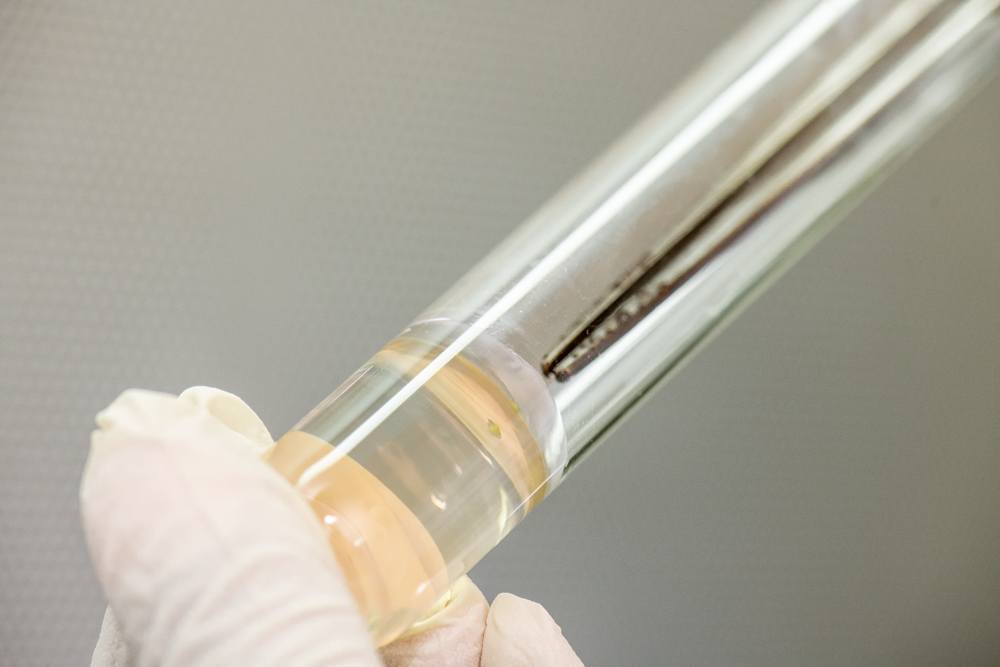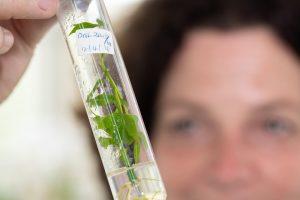In vitro culture, or plant tissue culture, is a technology of growing plants under sterile conditions in a controlled environment. The latter is provided by using a laboratory-prepared medium with known concentrations of nutrients, vitamins and growth regulators and growth chambers with controlled light, temperature and humidity. While achieving better control over plant development and health status, in vitro culture requires less space compared to field collections and hence is often used to safely duplicate accessions of clonally propagated crops that cannot be conserved as seeds.
Plants in vitro are propagated by cutting them into nodal sections that are subsequently transferred to a fresh medium. This procedure known as “subculture” is normally repeated every 4-6 weeks. However, in the genebanks, subculture periods for most crops are extended to 6-24 months due to “slow growth conditions”: using chemicals that suppress plant growth and lowering the temperature and light intensity in growth chambers.

Meristems are placed in in vitro media for regeneration into a whole plant. The small meristem can be seen in media. Photo: Michael Major/Crop Trust
CGIAR genebanks maintain over 23,000 accessions of vegetatively propagated crops in vitro. Collections are held in CIP (potato, sweetpotato, Andean roots and tubers), CIAT (cassava), IITA (cassava, yam, banana) and Bioversity International (banana and plantains).
In vitro plants are used to safely duplicate accessions from field collections, for aseptic plant production, safe and easy international exchange of phytosanitary clean material, for cytogenetic and molecular characterisation, and as donor materials for cryopreservation. Another important application of in vitro culture is phytosanitary cleaning. The apical shoot tip of the infected plant which contains no or less concentration of pathogenic agents is dissected and used to regenerate a healthy plant. This method is often combined with other treatments such as chemo and thermotherapy. For example, in CIAT, shoot tip culture combined with cryotherapy (exposure to liquid nitrogen) is applied to eliminate cassava common mosaic virus (CCMV) and a Reovirus associated with cassava frog skin disease (CFSD).
While they are an attractive approach to conserve plant germplasm, in vitro cultures remain labour intensive. Another major impediment of tissue culture storage is the possibility of genetic instability due to somaclonal variation (mutations that occur spontaneously in vivo or in vitro, whose frequency is generally increased over the years).
The four centers together with their national and international partners run research programs focused on advancing in vitro conservation of tropical crops and using it for crop improvement.
CGIAR links
- CIP in vitro genebank
- IITA Cassava in vitro processing and gene banking manual
- IITA Yam in vitro genebanking manual (PDF)
- IITA Standard Operation Procedures (SOP) for in vitro genebank (PDF)
Further reading
FAO. 2014. Genebank Standards for Plant Genetic Resources for Food and Agriculture. (Standard for in vitro conservation can be found on pages 134-138).
Genebanks CRP Annual Report 2016. Bonn: Global Crop Diversity Trust.
Reed, B.M., Engelmann, F., Dulloo, M.E., Engels, J.M.M. 2004. Technical guidelines for the management of field and in vitro germplasm collections. IPGRI Handbooks for Genebanks No. 7. International Plant Genetic Resources Institute, Rome, Italy.
Pence, V.C., Sandoval, J.A., Villalobos, V.M, Engelmann, F. (eds.) 2002. In vitro collecting techniques for germplasm conservation. IPGRI technical bulletin, 7.
Benson, E.E., Harding, K., Debouck, D., Dumet, D., Escobar, R., Mafla, G., Panis, B., Panta, A., Tay, D., Van den Houwe, I., Roux, N. 2011. Refinement and standardization of storage procedures for clonal crops.
- Part I. Project landscape and general status of clonal crop in vitro conservation technologies
- Part 2. Status of in vitro conservation technologies for: Andean root and tuber crops, cassava, Musa, potato, sweetpotato and yam
- Part 3. Multi-crop guidelines for developing in vitro conservation best practices for clonal crops
Selected publications
Angel, F., Barney, V.E., Tohme, J., Roca, W.M. 1996. Stability of cassava plants at the DNA level after retrieval from 10 years of in vitro storage. Euphytica 90: 307–313.
Bairu, M.W., Aremu, A.O., Van Staden, J. 2011. Somaclonal variation in plants: causes and detection methods. Plant Growth Regulation 63: 147–173.
Drapal, M., Carvalho, E., Van den Houwe, I., Rouard, M., Sardos, J., Amah, D., Swennen, R., Roux, N., Fraser, P. 2016. A metabolomics approach to the assessment of banana diversity and traits. [Poster abstract] presented at XXIV Plant and Animal Genome Conference. San Diego, CA (USA) 9-13 Jan 2016.
Escobar, R.H., Hernández, C., Larrahondo, N., Ospina, G., Restrepo, J., Muñoz, L., Tohme, J., Roca, W.M. 2006. Tissue culture for farmers: participatory adaptation of low-input cassava propagation in Colombia. Experimental Agriculture 42: 103–120.
Escobar, R.H., Restrepo, J., Tohme, J., Roca, W.M. 2013. Use of tissue culture in cassava for rural households in Colombia. In: Ruane J, Dargie JD, Mba C, Boettcher P, Makkar HPS, Barthey DM, Sonnino A (eds) Biotechnologies at work for smallholders: Case studies from developing countries in crops, livestock and fish. Food and Agriculture Organization of the United Nations (FAO) Rome, pp 56–62.
Garming, H., Roux, N., Van den Houwe, I. 2010. The impact of the Musa International Transit Centre. Bioversity International, Montpellier, France.
Hribova, E., Cizkova, J., Van den Houwe, I., Swennen, R., Roux, N., Dolezel, J. 2014. Characterisation of accessions held at the International Musa Genebank. Tropentag 2014. International Conference on Research on Food Security, Natural Resource Management and Rural Development.
Iwanaga, M. 1994. Cassava genetic resources management at CIAT International network for cassava genetic resources. Report of the first meeting of the International Network for Cassava Genetic Resources held at CIAT, Cali, Colombia, 18-22 August 1992. International Crop Network Series no. 10. p. 77-86.
Jarret, R.L., Florkowski, W.J. 1990 In vitro active vs. field gene bank maintenance of sweetpotato germplasm: Major costs and considerations. Horticultural Science 25: 141–146.
Vanhove, A.C., Vermaelen, W., Panis, B., Swennen, R., Carpentier, S.C. 2012. Screening the banana biodiversity for drought tolerance: can an in vitro growth model and proteomics be used as a tool to discover tolerant varieties and understand homeostasis. Frontiers in Plant Science 3, article 176.











